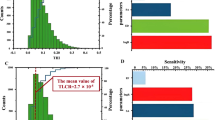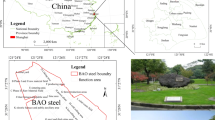Abstract
Stomach cancer (SC) is a severe health burden, with nearly half of the world’s cases found in China. Noticeably, the emissions of heavy metals into the environment have increased alongside rapid urbanization and industrialization in China. However, as regards carcinogenic associations, the relationship between heavy metals and SC is yet unclear. Based on 9378 newly diagnosed SC cases in Hangzhou City from 2009 to 2012, this work is concerned with the quantitative characterization of the spatial distribution pattern of SC incidence and its geographical association with soil heavy metals by means of a novel geographical model. The results show that (a) Cd is one of the severe soil pollutants in Hangzhou; (b) higher SC incidence clusters are in central Hangzhou, whereas lower clusters are found in the northeast and southwest with a male to female incidence ratio about 2.2:1; (c) although when considered separately, the heavy metals in this work do not have a considerable impact on the distribution of SC incidence in Hangzhou City, nevertheless, the joint effects of multiple heavy metals have significant impacts on SC risk. The present work calls for a rigorous quantitative assessment of the integrated heavy metal soil pollution and its effects on SC incidence.




Similar content being viewed by others
Explore related subjects
Discover the latest articles, news and stories from top researchers in related subjects.References
Amin, M. M., Kazemi, A., Eskandari, O., Ghias, M., Fatehizadeh, A., & Zare, M. R. (2015). Geographical distribution of stomach cancer related to heavy metals in Kurdistan, Iran. International Journal on Environmental Health Engineering, 4, 12.
Brenner, H., Rothenbacher, D., & Arndt, V. (2009). Epidemiology of stomach cancer. Methods in Molecular Biology, 472, 467–477.
Bryan, N. S., Alexander, D. D., Coughlin, J. R., Milkowski, A. L., & Boffetta, P. (2012). Ingested nitrate and nitrite and stomach cancer risk: An updated review. Food and Chemical Toxicology, 50(10), 3646–3665.
Chen, K., Liao, Q. L., Ma, Z. W., Jin, Y., Hua, M., Bi, J., et al. (2015). Association of soil arsenic and nickel exposure with cancer mortality rates, a town-scale ecological study in Suzhou, China. Environmental Science and Pollution Research International, 22(7), 5395–5404.
Chen, W., Zheng, R., Baade, P. D., Zhang, S., Zeng, H., Bray, F., et al. (2016). Cancer statistics in China, 2015. CA: A Cancer Journal for Clinicians, 66(2), 115–132.
Chen, W., Zheng, R., Zhang, S., Zeng, H., Zou, X., & He, J. (2017). Report of cancer incidence and mortality in China 2013. China Cancer, 26(1), 1–7.
Christakos, G. (1992). Random field models in earth sciences. San Diego, CA: Academic Press.
Christakos, G. (2017). Spatiotemporal random fields: Theory and applications. Amsterdam: Elsevier.
Crew, K. D., & Neugut, A. I. (2006). Epidemiology of gastric cancer. World Journal of Gastroenterology, 12, 354–362.
Epperson, B. K., & Li, T. (1996). Measurement of genetic structure within populations using Moran’s spatial autocorrelation statistics. Proceedings of the National Academy of Sciences USA, 93(19), 10528–10532.
Estève, J., Benhamou, E., & Raymond, L. (1994). Statistical methods in cancer research volume IV: Descriptive epidemiology. Volume Chapter 2. Lyon: IARC Scientific Publication.
Fei, X., Wu, J., Liu, Q., Ren, Y., & Lou, Z. (2016). Spatiotemporal analysis and risk assessment of thyroid cancer in Hangzhou, China. Stochastic Environmental Research and Risk Assessment, 30(8), 2155–2168.
Ferlay, J., Soerjomataram, I., Dikshit, R., Eser, S., Mathers, C., Rebelo, M., et al. (2015). Cancer incidence and mortality worldwide: Sources, methods and major patterns in GLOBOCAN 2012. International Journal of Cancer, 136(5), E359–E386.
Han, W., Gao, G., Geng, J., Li, Y., & Wang, Y. (2018). Ecological and health risks assessment and spatial distribution of residual heavy metals in the soil of an e-waste circular economy park in Tianjin, China. Chemosphere, 197, 325–335.
Hao, J., & Chen, W. Q. (2012). Chinese Cancer registry annual report. Beijing: Military Medical Science Press.
Hu, B., Jia, X., Hu, J., Xu, D., Xia, F., & Li, Y. (2017). Assessment of heavy metal pollution and health risks in the soil–plant–human system in the Yangtze river delta, china. International Journal of Environmental Research and Public Health, 14(9), 1–18.
Huang, Y., Chen, H., Zhou, L., Li, G., Yi, D., & Zhang, Y., et al. (2017). Association between green tea intake and risk of gastric cancer: A systematic review and dose-response meta-analysis of observational studies. Public Health Nutrition, 20(17), 3183–3192.
Jan, F. A., Ishaq, M., Khan, S., Ihsanullah, I., Ahmad, I., & Shakirullah, M. (2010). A comparative study of human health risks via consumption of food crops grown on wastewater irrigated soil (Peshawar) and relatively clean water irrigated soil (lower Dir). Journal of Hazardous Materials, 179, 612–621.
Krstev, S., Dosemeci, M., Lissowska, J., Chow, W. H., Zatonski, W., & Ward, M. H. (2005). Occupation and risk of stomach cancer in Poland. Occupational and Environmental Medicine, 62(5), 318–324.
Li, X., Xie, Y., Wang, J., Christakos, G., Si, J., Zhao, H., et al. (2013). Influence of planting patterns on fluoroquinolone residues in the soil of an intensive vegetable cultivation area in northern China. Science of the Total Environment, 458–460(3), 63–69.
López-Abente, G., Locutura-Rupérez, J., Fernández-Navarro, P., Martín-Méndez, I., Bel-Lan, A., & Núñez, O. (2018). Compositional analysis of topsoil metals and its associations with cancer mortality using spatial misaligned data. Environmental Geochemistry and Health, 40(1), 283–294.
Malekzadeh, R., Derakhshan, M. H., & Malekzadeh, Z. (2009). Gastric cancer in Iran: Epidemiology and risk factors. Archives of Iranian Medicine, 12(6), 576–583.
Matthews, S. A. (1990). Gastric cancer: An epidemiological review. Environmental Geochemistry and Health, 12(3), 201–214.
McKinley, J. M., Ofterdinger, U., Young, M., Barsby, A., & Gavin, A. (2013). Investigating local relationships between trace elements in soils and cancer data. Spatial Statistics, 5, 25–41.
MEP, M. L. R. (2014). National soil pollution survey bulletin. Ministry of Environmental Protection and Ministry of Land and Resources, Beijing. http://www.zhb.gov.cn/gkml/hbb/qt/201404/W020140417558995804588.pdf. Accessed 17 Apr 2014.
Myung, S. K., Bae, W. K., Oh, S. M., Kim, Y., Ju, W., Sung, J., et al. (2009). Green tea consumption and risk of stomach cancer: A meta-analysis of epidemiologic studies. International Journal of Cancer, 124(3), 670–677.
Olea, R. A. (2006). A six-step practical approach to semivariogram modeling. Stochastic Environmental Research and Risk Assessment, 20(5), 307–318.
Pakzad, R., Khani, Y., Pakzad, I., Momenimovahed, Z., Mohammadian-Hashejani, A., Salehiniya, H., et al. (2016). Spatial analysis of stomach cancer incidence in Iran. Asian Pacific Journal of Cancer Prevention, 17(S3), 27–32.
Putila, J. J., & Guo, N. L. (2011). Association of arsenic exposure with lung cancer incidence rates in the United States. PLoS ONE, 6(10), e25886.
Qiao, M., Cai, C., Huang, Y., Liu, Y., Lin, A., & Zheng, Y. (2011). Characterization of soil heavy metal contamination and potential health risk in metropolitan region of northern China. Environmental Monitoring and Assessment, 172(1–4), 353–365.
Rapant, S., Cvečková, V., Dietzová, Z., Fajčíková, K., Hiller, E., Finkelman, R. B., et al. (2014). The potential impact of geological environment on health status of residents of the slovak republic. Environmental Geochemistry and Health, 36(3), 543–561.
Sitas, F. (2016). Twenty five years since the first prospective study by Forman et al. (1991) on Helicobacter pylori and stomach cancer risk. Cancer Epidemiology, 41, 159–164.
Waalkes, M. P. (2003). Cadmium carcinogenesis. Mutation Research Fundamental and Molecular Mechanisms, 533(1–2), 107–120.
Wang, J. F., & Hu, Y. (2012). Environmental health risk detection with GeogDetector. Environmental Modelling and Software, 33, 114–115.
Wang, J. F., Li, X. H., Christakos, G., Liao, Y. L., Zhang, T., Gu, X., et al. (2010). Geographical detectors-based health risk assessment and its application in the neural tube defects study of the Heshun Region, China. International Journal of Geographical Information Science, 24, 107–127.
Wang, X. Q., Terry, P. D., & Yan, H. (2009). Review of salt consumption and stomach cancer risk: Epidemiological and biological evidence. World Journal of Gastroenterology, 15(18), 2204–2213.
Welling, R., Beaumont, J. J., Petersen, S. J., Alexeeff, G. V., & Steinmaus, C. (2015). Chromium VI and stomach cancer: A meta-analysis of the current epidemiological evidence. Occupational and Environmental Medicine, 72(2), 151–159.
Yang, Y., Christakos, G., Guo, M., Xiao, L., & Huang, W. (2017). Space-time quantitative source apportionment of soil heavy metal concentration increments. Environmental Pollution, 223, 560–566.
Yuan, W., Yang, N., & Li, X. (2016). Advances in understanding how heavy metal pollution triggers gastric cancer. BioMed Research International, 2016(1), 7825432.
Zhao, Q., Wang, Y., Cao, Y., Chen, A., Ren, M., Ge, Y., et al. (2014). Potential health risks of heavy metals in cultivated topsoil and grain, including correlations with human primary liver, lung and gastric cancer, in Anhui province, Eastern China. Science of the Total Environment, 470–471(2), 340–347.
Acknowledgements
This work was Funded by the National Natural Science Foundation of China (Grant No. NSFC 41671399).
Author information
Authors and Affiliations
Corresponding author
Rights and permissions
About this article
Cite this article
Fei, X., Lou, Z., Christakos, G. et al. The association between heavy metal soil pollution and stomach cancer: a case study in Hangzhou City, China. Environ Geochem Health 40, 2481–2490 (2018). https://doi.org/10.1007/s10653-018-0113-0
Received:
Accepted:
Published:
Issue Date:
DOI: https://doi.org/10.1007/s10653-018-0113-0




